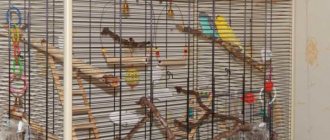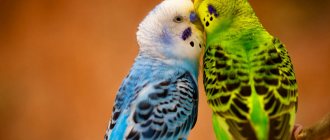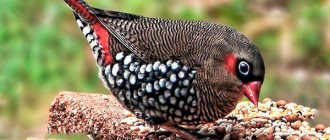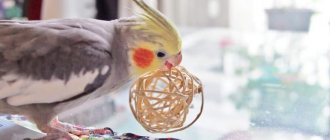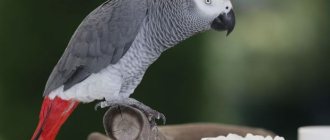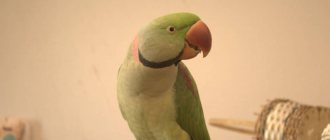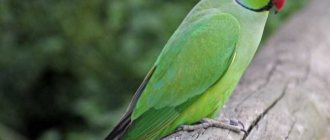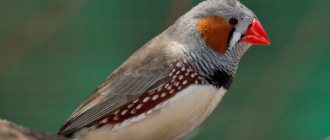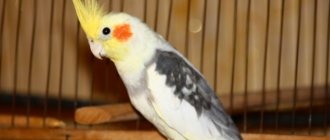- Wild animals
- >>
- Birds
Budgerigar - has a greenish-yellow coloration with black wavy markings on the back of the head, back and wings. In captivity they are bred with blue, white, yellow, gray coloring and even small combs. Budgerigars were first discovered in 1805 and have become extremely popular pets due to their small size, reasonable price, and ability to imitate human speech. Birds are the third most popular pet after domesticated dogs and cats. They have been bred in captivity since the 19th century.
Origin of the species and description
Photo: Budgerigar
The genus name Melopsittacus is translated from ancient Greek as “melodic parrot.” It is the only species in the genus Melopsittacus. The birds coexisted with Indigenous Australians for 70,000 years. The species was first described by George Shaw in 1805, and the current binomial name was assigned to the bird by John Gould in 1840. An outstanding ornithologist compiled a more complete review of the life of budgerigars in nature in the book “Birds of Australia”, where he elaborated on the characteristics of this species. In 1840, budgerigars arrived on the European continent.
The species was originally thought to be a link between the genera Neophema and Pezoporus (based on its webbed plumage). However, recent phylogenetic studies using DNA sequences place the budgerigar very close to the wax parrots or lorinii (tribe Loriini) and fig parrots (tribe Cyclopsittini).
Fun fact: Budgerigars come in more colors than most other bird or animal species. The diffuse colors of their plumage are emphasized by ultraviolet light, especially on the sides of the cheeks, which play a role in sexual dimorphism.
Budgerigars are widely known domestic birds. Their number as pets reaches 5,000,000 individuals worldwide, which has provided scientists with ample opportunities to study their habits. More is known about their biological characteristics than about any other species. There are approximately 150 species of domestic budgerigar. The first changes in the color of the bird happened spontaneously due to mutations, and later, as a result of selection and breeding experiments, they reached enormous diversity.
Criteria for choosing a cage
When approaching the question of choosing a home for a bird, consider the following factors:
- cell shape. A rectangular one with a flat roof would be ideal. It makes it easier for the parrot to move around and it will be easier to hang toys.
- size. Remember, the bird must freely straighten its wings and move around its home.
- twigs. To prevent your parrot from sliding along the walls, try to purchase a cage with twigs arranged horizontally.
- care and cleanliness. For ease of cleaning, choose a cage with a simple design. You need to clean every day, and do a general cleaning every month. You can disinfect the cage with chamomile infusion or wormwood infusion.
- safety. To prevent your bird from breaking its leg between the bars, buy a cage with a flat bottom.
Appearance and features
Photo: Green budgerigar
Wild budgerigars are on average 18 cm in length, weigh 30–40 g, have a wingspan of 30 cm, and have a light green body color. Their back and wings show black stripes of pattern. The forehead and face of adults are yellow. The cheeks have small iridescent blue-violet spots, and the neck has a series of three black spots on each side. The two outermost cervical spots are located at the base of the cheek spots. The tail is cobalt (dark blue). Their wings are greenish-yellow with black stripes. The bill is olive-gray and the legs are bluish-gray, with zygodactyl toes.
Video: Budgerigar
In their natural Australian environment, budgerigars are noticeably smaller in size than their captive counterparts. The upper part of the beak is higher than the lower and covers it when closing. The beak does not protrude much forward due to the thick fluffy feathers surrounding it, giving the appearance of a downward-pointing beak lying directly on the face. Its upper half has a long, smooth cover, while the lower half is a recessed cup. This beak structure allows birds to quickly eat plants, fruits and vegetables.
Interesting fact: The feathers on the heads of budgerigars reflect ultraviolet radiation.
The sex of a budgie older than six months can be easily determined by its skin color, but the bird's behavior and head shape also help in this matter. Veterinarians determine the sex of a bird through invasive examination or examination of samples of blood, feathers and eggshells. Mature males are usually light to dark blue, but in some specific mutations they can be purple to pink. The neck is very mobile, since the main grasping function is performed by the beak. The supporting function is performed by the skeleton of the body, therefore it is inactive. The bird's flight is slightly arched.
Price
You can purchase a feathered pet from a professional breeder, at a pet store, at a bird market, or through advertisements on the Internet. The first two options allow you to be sure that the bird grew up in the right conditions and find out all the information about its birth and growing up. Other methods save money, but there is a risk of purchasing a sick or old bird. It is also impossible to check the conditions of its detention.
It is better to buy a young chick; it should have even feathers, clean eyes and a whole body. The most important quality of this breed is activity and curiosity, so if the bird does not show curiosity, this is very strange, and you should refuse to purchase it.
The price of birds varies greatly depending on various factors. On average, we can talk about amounts from 250 rubles per bird. From professional breeders or in special nurseries, the price can reach 3,000 rubles.
Where does the budgerigar live?
Photo: Budgerigars
The habitat of Melopsittacus undulatus, commonly known as the budgerigar, is evenly distributed throughout Australia, with the exception of coastal areas in the east of the continent and in the far southwest.
This species has been introduced to many areas of the world, including:
- South Africa;
- Japan;
- USA;
- Puerto Rico;
- Switzerland;
- New Zealand.
However, it has successfully taken root in the natural environment only in southwest Florida. Increasing competition for nesting sites for European starlings and house sparrows is thought to be the main reason for the population decline since the 1980s. The more constant year-round conditions in Florida have greatly reduced their nomadic behavior.
Budgerigars occupy a range of semi-arid and sub-humid habitats, mainly in the Australian interior. However, they can sometimes be found in the dry grasslands of the southeast. Although their distribution is generally limited to the interior of the continent, periodic interruptions in their distribution on the coast occur in the northeast and central south.
Budgerigars are nomadic, their flocks leaving the area when environmental conditions change. Seasonal migration north during winter is associated with the search for food sources. Budgerigars are found in open habitats, mainly in bushland, sparse forests and grasslands of Australia.
Birds typically form small flocks, but under favorable conditions they can form very large flocks. The nomadic nature of the flock is associated with the availability of food and water. Drought may drive birds to more wooded areas or coastal areas.
Interesting Facts
The budgerigar is a unique bird in its family, as evidenced by the following features:
- Tenacious paws with 4 claws - 2 claws pointing forward, 2 backward. This structure allows you to deftly climb trees and confidently and quickly walk on the ground. Parrots are a rare species of birds that are able to take food not only with their beaks, but also with their paws.
- Excellent hearing and good sense of rhythm. They can really grasp the tempo subtly and move rhythmically to the beat.
- Birds have a developed memory and remember words. But they repeat them mechanically, without grasping the meaning. In 1995, Puck the parrot was included in the Guinness Book of Records for learning more than 1,700 words.
- Movable neck. The muscles are so flexible that the bird is able to turn its head 180 degrees.
- Keen vision, with a wide overview. They see the world in color.
- Parrots do not have vocal cords. They make sounds using the larynx and tongue, which is short and thick.
Budgerigars are calm and hardy birds. In their homeland, they know how to adapt to weather conditions and are not afraid of winds and rains. They are tirelessly busy searching for food and taking care of their family. In their natural habitat, they know how to live harmoniously in a flock and overcome difficulties together with their wavy brothers.
What does a budgie eat?
Photo: Blue budgerigar
Wavy varieties are very successful developers of food and water resources. They feed on the ground and therefore prefer to collect grass and crop seeds, particularly spinifex and tuft grasses. In addition, their diet includes young shoots, fruits and berries. In nature, parrots eat grains of varying degrees of maturity, and they especially like young milk seeds.
Interesting fact: This species destroys growing grain crops and lawn grass seeds. Their ability to consume large quantities of seeds in swarms affects the interests of farmers.
They first clean the seeds and then swallow it whole or try to break it apart. The seeds are extremely rich in energy and are equivalent to the caloric content of animal tissue. Therefore, birds do not require an alternative food source. Budgerigars are very frequent water drinkers, drinking about 5.5% of their body weight per day. To meet this demand, they are often located near water sources.
Their activity, like that of most birds, begins shortly before sunrise with cleaning, singing and moving around within the trees. After sunrise, the birds fly to the feeding area and feed there throughout the day. They do not forage during midday or in very hot weather, instead they take refuge in the shade and remain motionless. At the end of the day, budgies gather, calling loudly and flying at high speeds around the trees. They then return to their roosting site just after sunset and remain alone until the next morning.
Animal proteins in the bird's diet
In addition to plant foods, about which much has already been said above, animal proteins can and should be added to the diet. Here, preference can be given to grated boiled egg or low-fat cottage cheese.
Animal proteins are very important in the home; The budgerigar happily eats most foods containing proteins. This is the main supplementary feed of animal origin, including a lot of vitamins and minerals that are absent in feed of plant origin.
Protein should be given to the bird daily during nesting, seasonal molting, and hatching small chicks; in other cases, once a week is sufficient.
Try to feed a variety: don't limit yourself to just grains
They provide such perishable food fresh every day and remove the remnants of the previous food, which quickly rots and can cause illness. Often separate feeders are prepared for animal food. The most common and harmless additives for animal protein are:
- 1. Boiled chicken egg. Parrots at home especially readily feed on yolk, which contains the highest concentration of vitamins and essential organic substances.
- The egg is also rich in minerals: iron, iodine, potassium, phosphorus, sulfur, chlorine, bromine. It is boiled for birds kept at home, hard-boiled and finely chopped.
- Budgerigar lovers prepare soft egg mixtures for their pets, adding white crackers, grated fresh beets, carrots, and semolina to the eggs. It is useful to add a couple of drops of fat to a tablespoon of protein food. As a rule, the wavy eats such food if it is accustomed to it right away.
- 2. Low-fat cottage cheese is a source of healthy protein, important for bird health. It includes magnesium and essential vitamins, as well as lactic acid, phosphorus, essential iron, and potassium. This product is given to the bird fresh and crumbly.
- Poisoning is caused by an acidified product. It is allowed to add semolina to cottage cheese.
- 3. Fish oil includes vitamins A and D, phosphorus necessary for the feathered friend and a rare element - iodine. A couple of drops of it are mixed into grain feed.
- 4. Gammarus or mealworms are a nutritious protein food for parrots. In the wild, wild birds rarely eat insects, but for proper home care it is necessary to include such components.
Features of character and lifestyle
Photo: Budgerigar in nature
These are highly social birds and form large flocks. Their grouping allows for success in feeding, and also helps in protection from predators. Birds show signs of affection when they groom or feed each other. There is no hierarchy in these groups based on relatively few fights between individuals, but females tend to be more aggressive than males.
Interesting fact: Males are usually cheerful, very flirtatious, peacefully sociable, and make a lot of noise. Females tend to be highly dominant and more socially intolerant.
When a budgie feels threatened, it will try to climb as high as possible and bring its feathers closer to its body to appear thinner. They fly swiftly and move gracefully, walk slowly on the ground and masterfully climb trees. Their flocks can consist of from 20 to hundreds of individuals.
Tamed budgies can be taught to say words, whistle, and play with people. Both males and females sing and can learn to imitate sounds and words, as well as perform simple tricks. However, these skills are better improved in males. Females rarely learn to imitate only a dozen words. Males easily improve their vocabulary, ranging from several tens to a hundred words. Males kept alone are the best speakers.
Budgerigars will chew anything they can find to keep their beaks trimmed. In captivity, life expectancy is 15–20 years. This depends on the breed and health, which are greatly influenced by exercise and diet.
Nutrition
If you properly care for a budgie (boy or girl) after purchasing it (purchased at a pet store or from your own hands), it can live up to approximately 15 years. Balanced feeding (or the necessary diet) is an important component of proper keeping and care of parrots. These birds have a high body temperature (about 41 degrees) and, accordingly, have a fast metabolism. In this regard, the pet must eat the right way in order to promptly replenish its body with all the necessary nutrients.
Social structure and reproduction
Photo: Pair of budgerigars
Breeding for budgerigars can occur at any time of the year when there is an abundance of seeds. In northern Australia this occurs in winter, in southern Australia in spring and summer. In addition, budgies breed after heavy rains, because grass growth depends on the availability of water. In fact, any good rain triggers the breeding instinct, even when they are in the process of molting.
Budgerigars nest in existing cavities, which are found in logs and hollows of eucalyptus trees. Several nests can be found on the same tree branch at a distance of only 3-5 m from each other. They fill their nests with decomposed wood dust, droppings, and any other soft material available.
The female chooses a nest and incubates the eggs while the male spends most of his time searching for food. Parents often have several litters in a row. The eggs take about 18–20 days before they begin to hatch. The cubs are blind, naked, unable to raise their heads and completely helpless. The mother feeds them and keeps them warm at all times. The chicks develop feathers at three weeks of age. At this stage of chick development, the male begins to enter the nest to help the female care for and feed the chicks.
Interesting fact: Some female budgies categorically forbid the male from entering the nest and take full responsibility for raising the chicks until they fly away.
At approximately 10 days of age, the chicks' eyes open and plumage begins to develop. By the fifth week, the chicks are strong enough that the parents remain outside the nest most of the time. Young budgerigars begin trying to escape from the nest at five weeks. They achieve this at the age of six to eight weeks.
Place to place a bird
The owner must choose the room where household members spend the most time. Sociability is a characteristic feature of budgerigars. These are very highly social creatures. They need support from the pack, which all members of the new family should become.
Suitable lighting
It turns out that pets living in a person’s house do not receive the proper amount of ultraviolet radiation. An ordinary lamp does not highlight it, but the sun, passing rays through the glass, loses it. A special light source is needed, otherwise problems will begin with the endocrine system of the budgerigar. This is the reason:
- stress, stress
- self-plucking,
- weaknesses,
- impaired metabolism,
- impossibility of reproducing offspring.
A parrot needs suitable lighting
Our climate is not like the one in which their ancestors were born. Daylight hours are radically different. It must be artificially lengthened with the help of additional lighting.
Temperature
It is very hot on the Australian coasts and savannas, from where the wavy birds came to us. Sometimes the thermometer on the street shows 41 degrees Celsius. The body temperature of a parrot is the same. He can hardly bear the heat. We need comfortable 22-25. Below it is worse, the frost is much more dangerous. The owner can easily create the necessary indoor climate using heaters or ventilation. Additionally, you need to learn how to regulate the humidity level.
Read also
Setting up a cage for a budgie
Drafts
The birds' home is located where there is no through wind, as well as heating radiators and appliances. Sudden changes in heat and cold will cause a cold even in the most favorable weather. And dry air will negatively affect the growth and quality of plumage.
Place the cage where there are no drafts
Natural enemies of budgies
Photo: Budgerigar
Parrots are prey animals. They are most vulnerable when feeding on the ground. Membership in a herd plays an important role in providing security and improving the chances of survival from attacks by predators.
The most common predators of budgies include:
- hawks;
- eagles;
- owls;
- snakes (pythons and boas);
- jaguars;
- ocelots;
- monkey;
- the bats.
Some predators are only a risk during the day, while other nocturnal predators (owls, bats) are dangerous to budgies at night. Snakes grab parrots as they rest on tree branches, while birds of prey attack them as they fly or feed on the ground.
Interesting fact: Anti-predator instinct is the factor that influences the behavior of budgerigars in captivity more than any other.
Parrots are constantly on alert for danger, and they instinctively react to perceived threats. Their first reaction is to run away, however if this is not possible they will attack and fight with their powerful beaks to defend themselves. Budgerigars' visual abilities are genetically engineered to help detect threatening movement from a great distance.
Because their most threatening enemy is the hawk, parrots are particularly responsive to rapid movements from above and behind. For this reason, it is advisable to avoid making quick, sudden movements near the bird. This is an instinctive reaction that is not subject to logic or reason. Simple and relatively harmless household items can trigger extreme fear reactions in a bird.
Who are you: male or female?
To determine the sex of a wavy, first of all, pay attention to the wax. All chicks have it pink, but if you look closely, you will see light rings around the circumference of the nostrils on the girls.
By 4 months the cere changes color. In boys it becomes blue, in girls it becomes beige or pale blue, and by 8-9 months it turns brown.Is your parrot sick?
Improper care and handling of birds can cause the development of scabies, poisoning, inflammation of the goiter, damage to limbs, or infestation with down-eaters.
Signs of the disease for which you should immediately contact an ornithologist:
- ruffledness;
- refusal of food;
- loose stools;
- growths on the beak, around it, on the legs;
- discharge from the nostrils;
- lethargy and inactivity.

